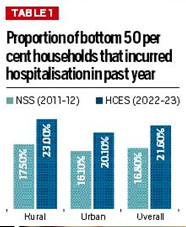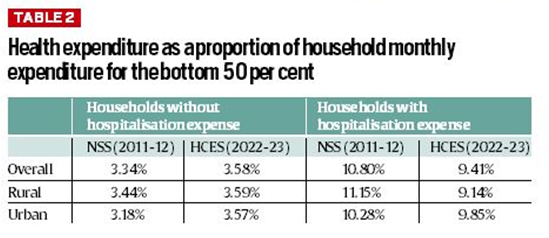REDUCING THE POOR’S HEALTH BURDEN
Relevance:
- GS 1 – Poverty and developmental issues
- GS 2 – Issues relating to poverty and hunger.
Why in the news?
- The Household Consumption Expenditure Survey (HCES 2022-23) shows a significant reduction in poverty rates since 2011-12.
- Beyond poverty, the focus should be on the vulnerability of households to adverse shocks, particularly those in the bottom 50% of the population.
- A household’s ability to cope with adverse shocks is crucial for overall well-being and is a key measure of welfare.
- Quantifying a household’s vulnerability to shocks remains a challenging task.
Household Vulnerability as a challenge
- Increase in Hospitalisation Expenditure: The proportion of households in the bottom 50% incurring hospitalisation expenses increased from 17% in 2011-12 to 22% in 2022-23. For rural households, this figure rose from 18% to 23%, and for urban households, it increased from 16% to 20%.
- Improved Healthcare Accessibility: This increase reflects a significant improvement in access to healthcare for the poorest 50% of the population across both rural and urban areas of India.
- Health Expenditure Ratio Analysis: For the bottom 50% of households, health expenditure without hospitalisation increased slightly from 3.3% of monthly household expenditure in 2011-12 to 3.6% in 2022-23.
- In contrast, households that experienced hospitalisation saw a notable decline in the share of health expenditure as a ratio of their monthly household expenditure, decreasing from 10.8% to 9.4% over the same period.
- Economic Burden: Health shocks not only restrict individual freedom but also impose a heavy economic burden on families as essential resources are redirected from other needs to cover medical costs.
Rural-Urban Differences in Health Expenditure Ratios
These findings indicate that healthcare involving hospitalisation expenses is becoming more affordable for the poorest 50% of the Indian population, especially in rural areas.
- Rural Areas:
- For the bottom 50%, the ratio of health expenditure without hospitalisation increased slightly from 3.4% to 3.6% over 11 years.
- For households that experienced hospitalisation, the ratio significantly declined from 11.15% to 9.14% during the same period.
- Urban Areas:
- The ratio of health expenditure for households without hospitalisation increased marginally from 3.2% to 3.6%.
- For those that experienced hospitalisation, the ratio decreased from 10.3% to 9.9%.
Impact on Consumption Status Due to Hospitalisation
- The aim is to demonstrate that households with high medical spending due to hospitalisation may not have sufficient resources for other essential items.
- Vulnerability and Consumption Status:
- Among the poorest 50%, 40% of households that experienced hospitalisation in 2011-12 faced a decline in consumption status.
- By 2022-23, despite the rise in hospitalisation incidence, only 33% of these households experienced a decrease in consumption status.
- Reduction in Odds of Decline:
- These results indicate a 23% reduction in the odds of households facing a decline in consumption status due to hospitalisation.
- This effect is more pronounced in rural areas, where 44% of the bottom 50% of households that incurred hospitalisation expenses faced a decline in consumption status in 2011-12, reducing to 36% by 2022-23—a 29% reduction in odds.
- For poor urban households, the odds of facing a decline in consumption status due to hospitalisation fell by 14% over the 11 years.
Healthcare Accessibility and Affordability
- Increased Accessibility and Affordability: Over the past decade, healthcare has become more accessible and affordable for the bottom 50% of the Indian population.
- Decline in Vulnerability: There has been a significant decline in the odds of households facing a loss in overall consumption status due to the financial burden of hospitalisation, a key indicator of reduced vulnerability.
- Rural Households and Vulnerable Groups: The positive trends are more pronounced among rural households. Households with young children and elderly members show particularly strong improvements.
- Public Health Policy Impact: These trends are closely linked to public health initiatives in India, especially the Ayushman Bharat Yojana, which aims to alleviate the financial burden of hospitalisation for the poor.
Way Forward
- Enhance Public Health Initiatives: Strengthen and expand programs like the Ayushman Bharat Yojana to ensure broader coverage and accessibility for low-income households.
- Focus on Rural Healthcare: Increase investment in rural healthcare infrastructure to further improve access and affordability for the poorest segments, addressing the specific needs of rural populations.
- Strengthen Health Insurance Coverage: Promote health insurance schemes tailored for low-income families to reduce out-of-pocket expenses and financial risks associated with hospitalization.
- Monitor Health Expenditure Trends: Regularly assess health expenditure ratios and hospitalization rates to identify trends and areas needing intervention, ensuring timely responses to emerging challenges.
- Support Vulnerable Groups: Implement targeted support for households with young children and elderly members, who may face higher health risks and financial burdens due to medical expenses.
- Promote Preventive Healthcare: Encourage preventive healthcare measures and regular health check-ups to reduce the incidence of severe health issues that lead to hospitalization.
- Facilitate Access to Essential Medicines: Ensure the availability and affordability of essential medicines and treatments, particularly in underserved areas, to reduce overall health expenditure.
- Encourage Community Health Programs: Foster community-based health programs that provide localized support and resources, enhancing overall health outcomes and reducing vulnerability.
- Evaluate Policy Impact: Continuously evaluate the effectiveness of health policies and programs, making data-driven adjustments to improve their impact on poverty reduction and health accessibility.
Alternative articles
https://universalinstitutions.com/analysis-of-public-health-spending-in-india/
https://universalinstitutions.com/a-system-that-heals/
Source: https://indianexpress.com/article/opinion/columns/ayushman-bharat-india-poor-9501487/
Mains question
Discuss the impact of public health policies on healthcare accessibility and affordability. Access the household vulnerability in rural and urban India over the past decade.” (250 words)





